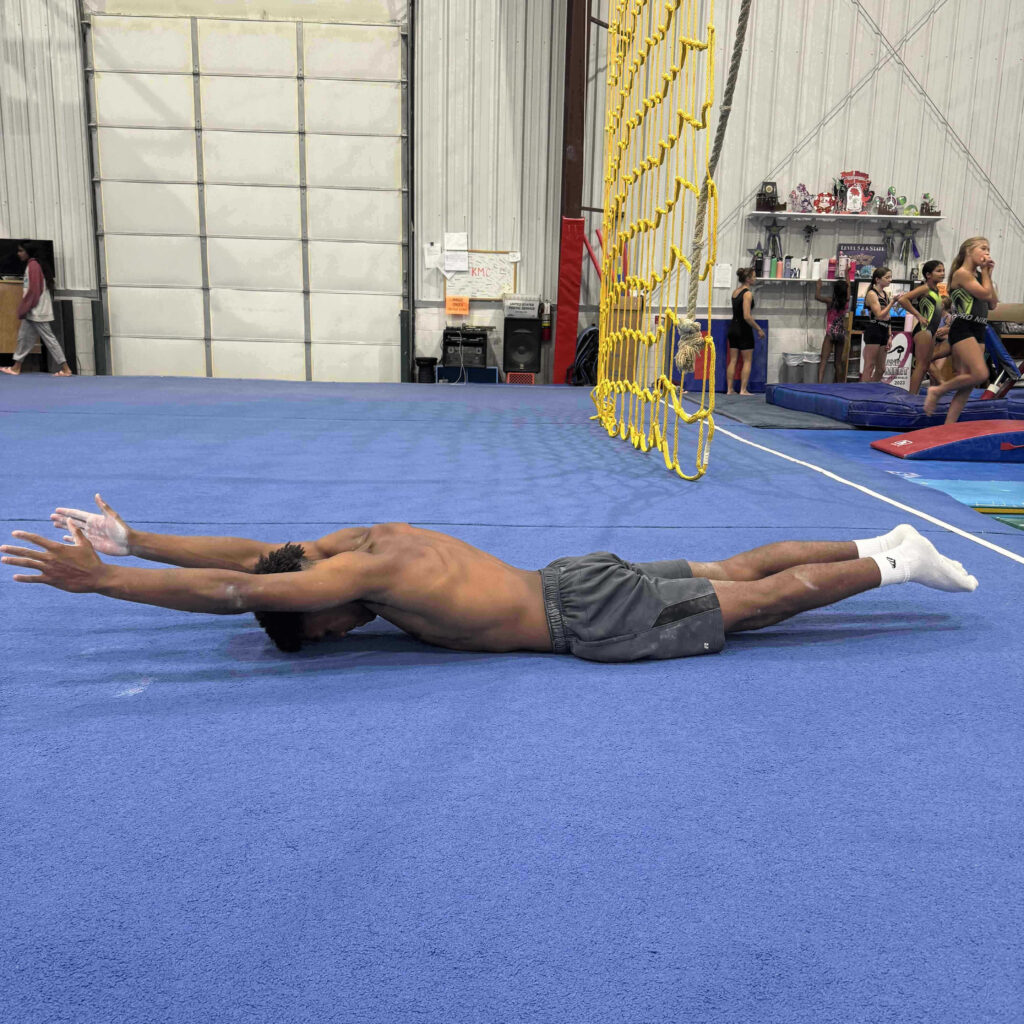Summary
Simple shapes make up most gymnastics skills. The most common basic shapes in gymnastics include:
- The Straight Line and Handstand
- Hollow and Arch
- Tuck, Pike, and Straddle
Mastering these shapes and moving between them allows gymnasts to create more complex gymnastics elements.
A few simple shapes compose most gymnastics skills. By perfecting and combining the basic shapes in gymnastics, elite athletes can perform high-caliber skills worthy of the Olympics. However, mastery of these simple elements is not easy and perfection of these building blocks takes years. Here, we will overview the most important basic shapes in gymnastics and how they build the complex skills that gymnasts learn.
The Shapes of Gymnastics

The Straight Line & Handstand
The handstand is king in gymnastics.
Appearing on every apparatus in the sport, mastery of the handstand leads to success in the sport.
A straight line involves the core and glutes squeezing to lock the torso, legs zipped together, with the arms pressing directly overhead covering the ears. Usually, the eyes will looking up toward the hands. This position can be performed laying down on your stomach and back, standing, hanging, and in the handstand.
The handstand involves balancing on your hands with the body in a straight line over the hands. Again, the straight line is key to the handstand.

When a gymnast performs an excellent handstand we will see a few key things:
- Straight Line and Stacked Body- The wrists, elbows, shoulders, hips, knees, and feet will all stack directly one over the other, and we will see that straight line body position locked in place.
- Covered Ears, Looking at the Hands- The arms and shoulders will cover the ears, and the eyes will look directly between the hands, not behind and not in front. We call this spot between the hands our anchor point.
- Standing As Tall As Possible- The gymnast will reach their toes to the ceiling as they push up and out of their shoulders. The goal is to be as extended as long as they can be.
Drills: Straight Body Stand Against Wall, Straight Body Hang, Headstand, Wall Facing Handstand.
Hollow and Arch
The hollow position involves rounding the chest and squeezing the stomach with legs zipped together and arms overhead covering your ears. Sometimes also called a dish, we often pair this position with an arch during skills.
The arch involves the same positions of the legs and arms, the gymnast extends their back and opens their chest.


Transitioning between the hollow and arch generates power. The action of hollow-arch-hollow occurs on tap swings on Uneven Bars and High Bar. Similarly, a back handspring involves this same Korbet action, aggressively moving from arch to hollow.
These positions also can describe what individual body parts are doing. For example, in a back layout we may want to hollow our chest, while placing the arms by our side, slightly arching the hips and low back.
Drills: Hollow Hold, Hollow Rocks, Arch Hold, Arch Rocks
Tuck, Pike, and Straddle
The tuck, pike, and straddle all fit together as they all are positions used to generate rotation when somersaulting.
The tuck involves bending the legs and pulling them close to the body, almost trying to turn the body into a ball.
A pike is similar but instead of bending the legs, the legs are kept straight and tight as the legs are pulled close to the body.
Lastly, a straddle is like a pike except the legs are apart, ideally as close to 180-degrees apart as possible.
Although commonly found in somersaulting elements, these positions are important for many other skills in gymnastics. The pike position is key for skills like the V-Sit and Manna. Gymnasts use the straddle position for leaps on floor and beam as well as elements in Men’s Gymnastics such as scissors and flairs on pommel horse.
Drills: Forward Roll, Backward Roll, Seated Pike Stretch, Pancake Stretch, Middle Split
Moving Shapes Create Complex Gymnastics Skills
Each skill in gymnastics is a combination of basic shapes. Moving from one shape into another in various patterns creates different skills.

Tap Swings on Bars
Let’s a look at a tap swing on bars. Hanging from the bar, the gymnast should show a nice hanging straight line shape. To move dynamically, the gymnast will move from hollow and arch positions.
A tap swing on bars shows a nice hollow body position behind the bar. As the body drops under the bar, the gymnast transitions to a nice hanging arch position. Exiting from below and moving in front of the bar, the gymnast returns to a nice hollow body shape.
When a tap swing is done very well, the gymnast eventually turns their tap swing into a giant swing. This giant swing starts in a handstand, uses the same hollow-arch-hollow as the tap swing, and returns to a handstand.
Back Handspring
Similarly, we can look at a back handspring the same way.
A gymnast performs a back handspring first by bending the knees and leaning back while maintaining a hollow body through the torso. Then, the athlete pushes through the floor, straightening the legs, and opening the hips while maintaining a hollow body. Once the hips are open and legs straight, the gymnast opens their chest and shoulders to bring the body into an arched handstand. A Korbet action is then performed to return to a hollow stand.
These basic skills and movement patterns then apply to create more complex gymnastics elements.
A flyaway off of bars uses the tap swing into a hollowed release to perform a dismount. Likewise, a Yurchenko vault uses the shapes and principles of a back handspring to perform a much more complicated vault. Even Simone Biles uses these same shapes when she performs her Yurchenko Double Pike.
